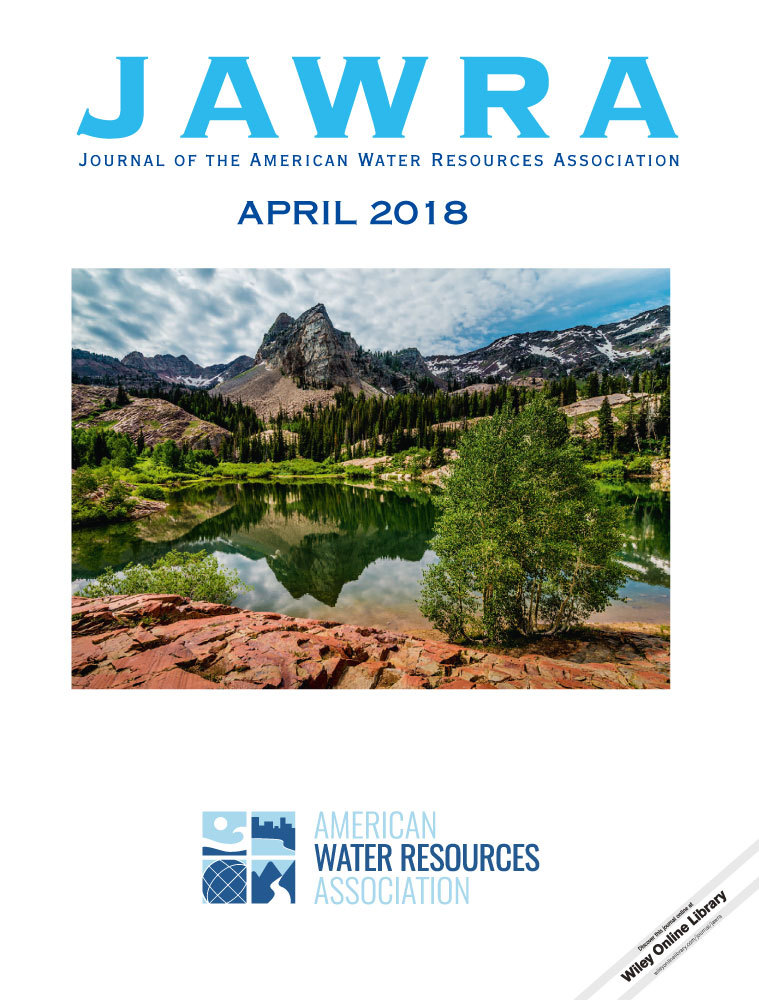Water Transactions for Streamflow Restoration, Water Supply Reliability, and Rural Economic Vitality in the Western United States†
Abstract
Across the western United States, environmental water transaction programs (EWTPs) restore environmental flows by acquiring water rights and incentivizing changes in water management. These programs have evolved over several decades, expanding from relatively simple two-party transactions to multiobjective deals that simultaneously benefit the environment and multiple water-using sectors. Such programs now represent an important water management tool and provide an impetus for collaboration among stakeholders; yet, most evaluations of their effectiveness focus exclusively on environmental outcomes, without adequate attention to impacts on other water users or local economies. To understand how these programs affect stakeholders, a systematic, multiobjective evaluation framework is needed. To meet this need, we developed a suite of environmental and socioeconomic indicators that can guide the design and track the implementation of water transaction portfolios, and we applied them to existing EWTPs in Oregon and Nevada. Application of the indicators quantifies impacts and helps practitioners design water transaction portfolios that avoid unintended consequences and generate mutually beneficial outcomes among environmental, agricultural, and municipal interests.
Introduction
During the past 150 years, rivers and streams across the western United States (U.S.) have been harnessed and diverted to serve a rapidly expanding human enterprise, providing water supplies for irrigated agriculture, mining, power generation, urban development, and a variety of other uses. Dams and diversions have profoundly altered natural water flows: During dry summer months, flows in more than half of all rivers in the western U.S. are now depleted by more than 50%, and one-fourth have lost more than 75% of their original flows (Richter et al., 2016). As a result, more than 20 native fish species have become extinct in the past century, and an estimated 367 freshwater plant and animal species are now imperiled in the western U.S., at least in part due to flow depletions (Minckley, 1997; Richter et al., 2016).
In recent decades, advocacy for flow restoration — returning water to streams, rivers, lakes, and wetlands — has been building. In some instances, these efforts have played out in the regulatory context, and have generated legal, political, and social controversy (Poff et al., 2003). In the western U.S., coalitions of public agencies, nongovernmental conservation organizations, and private businesses are countering this inclination by applying creative, market-based approaches to dedicating water rights and changing water management — both permanently and temporarily — to meet environmental water needs. Such strategies have protected and restored water-dependent ecosystems and species, and by extension, cultural and economic values that rely on water flowing in rivers (e.g., Wilson and Carpenter, 1999).
Environmental water transactionsrefer to agreements by which water users commit to change their water use to protect or restore environmental flows in exchange for compensation, investment, or regulatory relief. Such transactions include, but are not limited to, forbearance agreements (e.g., U.S. Bureau of Reclamation, 2007), dry-year options, deficit irrigation, water conservation agreements, crop substitution, split-season leases, infrastructure construction or reoperation, groundwater recharge and storage, use of alternative water sources, and traditional water rights sales and leases (Aylward, 2013). In this paper, instream flowrefers specifically to the legal appropriation of water rights to an instream purpose in the western U.S.; otherwise, we use the global convention, environmental flow(Arthington, 2012).
Environmental water transaction programs (EWTPs) emerged in Oregon and Washington in the 1990s as nonprofit water trusts, and have since grown in number, distribution, and complexity (Willey, 1992; Neuman and Chapman, 1999). However, few studies have retrospectively assessed the impacts of environmental water transactions on stakeholders or synthesized knowledge across programs. Understanding how these programs affect water users in different sectors (e.g., agricultural, environmental, municipal, and industrial) enables the programs to (1) improve their overall effectiveness of restoring environmental flows; (2) foster learning across programs to improve environmental water transaction design and implementation; (3) engage watershed stakeholders in dialogues around the economic, social, and environmental effects of environmental water transactions; (4) identify strategies that yield multisector benefits; and (5) compare different water transaction strategies for improving environmental flows. A framework that reveals ways in which water transactions can achieve multiple objectives across water-using sectors could potentially attract novel partnerships, mobilize new funding streams, and accelerate the restoration of environmental flows.
In this paper, we present a systematic framework for EWTPs to plan and evaluate transaction portfolios, which can be applied across geographic settings and diverse water management contexts. The framework consists of a set of indicators that monitor effects of water transaction portfolios on environmental, agricultural, and municipal stakeholders. Trends in indicator values help EWTPs adapt to different stakeholder needs and integrate their environmental goals into broader water management initiatives.
We first review the evolution of EWTPs. Next, we describe the framework and the rationale and approach for applying the proposed set of indicators. Finally, we apply the framework to existing EWTPs in Oregon and Nevada. A companion guidebook enables the evaluation of other existing or proposed water transaction programs (accessed January 2018, https://doi.org/10.5063/F13T9FCC).
Evolution of EWTPs
Within the U.S., state law governs the allocation and use of water. All the western states follow the prior appropriation doctrine, i.e., “first in time, first in right,” in which older, or senior, water rights have higher priority than newer, or junior, rights. In practice, many junior rights rarely, if ever, can be used. Two aspects of the prior appropriation doctrine historically created disincentives for leaving water in rivers. First, establishing a valid “beneficial use” generally required diverting water out of the river. Second, the “use it or lose it” rule meant that water rights holders who failed to divert and instead left their water rights instream risked forfeiting those rights.
Over the last few decades, changes in western water law have chipped away at these obstacles (Ziemer et al., 2016). In 1955, Oregon was the first state to establish instream flow for fish and wildlife as a beneficial use, with the other states eventually following. However, by the time states began issuing instream water rights, much of the available water had already been allocated to out-of-stream uses. California, for example, issued rights to use about five times more water than is physically available (Grantham and Viers, 2014). Therefore, the junior priority of the new instream flow rights often renders them ineffective. In response, several states, again led by Oregon (Neuman and Chapman, 1999; Aylward, 2008), began allowing water rights that are transferred to instream use to retain their original priority dates.
These reforms opened the door to market-based reallocation of water rights to the environment (Szeptycki et al., 2015; Szeptycki and Pilz, 2017). Because irrigated agriculture withdraws more than 60% and consumes more than 90% of all water used in the region (Western Water Policy Review Commission, 1998; Schaible and Aillery, 2012; Richter et al., 2016), senior irrigation rights constitute the primary source of water for market-based reallocation.
Early environmental water transactions had the single objective of restoring streamflow, and primarily involved low-cost projects targeting small streams where chronic dewatering threatened the survival of endangered fish species. These bilateral transactions, which acquired water rights from farmers and irrigation districts, sometimes by funding water-use efficiency projects, enabled EWTPs to build institutional capacity, forge relationships with irrigators, test water transaction mechanisms, and validate that acquired water remained instream (Neuman and Chapman, 1999; Aylward, 2008; Pilz and Aylward, 2013).
Disparities in the economic value of water use in different sectors have created challenges for environmental interests seeking to acquire water rights. The revenue generated by irrigated crops relative to the high prices that urban water utilities are willing to pay for water has stimulated multiple water rights transfers from farmers to municipal water utilities (Glennon, 2005; Brewer et al., 2006, 2007; Colby, 2016). Meanwhile, much of the “low-hanging fruit” – for example, water being put to relatively marginal uses — has already been harvested from willing sellers, leaving fewer opportunities and higher transaction costs for new acquisitions.
EWTPs are responding to these trends by pursuing increasingly complex transactions, which simultaneously meet demands of multiple stakeholders and reduce systemic risks for all water users and the environment (Colby, 1990; Tarlock, 1999; Cosens, 2003; Brewer et al., 2006; Hillman et al., 2012; Aylward et al., 2016b; Sanchez et al., 2016). Efforts to build strategic partnerships that bring multiple sectors into a common transaction framework are being undertaken in several western river basins, including:
- Colorado River Basin's System Conservation Pilot Program (U.S. Bureau of Reclamation, 2014);
- agricultural, environmental, and tribal partnerships creating and implementing the Yakima Basin Integrated Water Management Plan in central Washington (U.S. Bureau of Reclamation, 2012);
- Deschutes River Conservancy's (DRC) collaborations to restore flows in the Deschutes River Basin of central Oregon (DRC, 2015);
- Truckee River collaborations to meet urban water demands in Reno–Sparks, Nevada, and to secure environmental flows for Pyramid Lake fisheries and the Stillwater National Wildlife Refuge (Sanchez et al., 2016);
- binational negotiations that resulted in Minute 319 to the 1944 International Water Treaty for sharing Colorado River water between Mexico and the U.S. (International Boundary and Water Commission, 2012);
- Walker Basin Conservancy's collaborations to reduce the salinity of Walker Lake by increasing flows in its tributary, the Walker River (NFWF, 2016); and
- Yuba River Accord to meet environmental flow needs for anadromous salmonids and the water needs of irrigators (Ugai, 2017).
These efforts have achieved large-scale successes by embedding restoration goals within broader, multistakeholder water-sharing agreements to address shared water scarcity risks (e.g., Hawes, 2016). For example, in the Minute 319 and Minute 323 negotiations over management of the lower Colorado River, flow restoration was among the complex, competing objectives of participating U.S. and Mexican state and federal agencies, conservation groups, and major water users and managers. By setting clear restoration goals, contributing scientific expertise, working with local communities, and carrying equal financial burden for water acquisition, conservation groups secured environmental flows to restore degraded riparian habitat in the river's delta (King et al., 2014; Kendy et al., 2017). The contributions of the conservation groups to the broader negotiations and their willingness to share risk and responsibility shifted perceptions about the role of environmental advocates in addressing water scarcity.
Multisector Framework for Evaluating Water Transactions
As transactions become larger and more complex, both benefits and impacts accrue. Understanding the tradeoffs and unintended consequences of water reallocation is important, as impacts are rarely limited to buyers and sellers. For example, water sales can benefit agricultural communities by increasing revenues. Yet, the growing frequency of these sales has raised concerns that the permanent transfer of water rights away from agriculture undermines the long-term economic viability of rural communities (Hanak and Stryjewski, 2012). The environmental consequences of transactions for the environment are also mixed. For example, irrigation efficiency improvements can reduce irrigation return flows that support environmental flows (Cohen, 2014).
Yet effects of EWTPs on diverse stakeholder groups are not well documented. Despite their decades-long operational history, they still lack standardized metrics for assessing their impacts on different sectors, with whom they increasingly must collaborate.
Modeling approaches can help policy makers anticipate some of these impacts. Computable general equilibrium models predict economic impacts associated with changing water use patterns (Seung et al., 1998, 2000; Watson and Davies, 2011). Optimization models that integrate economic and hydrological parameters predict changes in crop production as farmers choose between irrigating or selling water, based on crop and input prices and land endowment (Hanak, 2005). These models have the advantage of exploiting microdata to elucidate complex relationships between agriculture, water policy, and the environment (Sunding et al., 1998; Howitt et al., 2012; Medellín-Azuara et al., 2012).
In contrast, empirical measures of water transaction outcomes facilitate ex post facto analyses of decisions made by real farmers, who lack the perfect information assumed by models, and instead base their water-selling decisions largely on unquantifiable cultural and emotional considerations (Michael et al., 2010; Douglas et al., 2016). While these analyses may inform policies, they are particularly useful to water market stakeholders themselves, who are likely to trust and respond to empirical metrics informed by their own concerns.
We offer an empirical framework for evaluating the impacts of water transactions on multiple sectors, illuminating tradeoffs, and minimizing uncertainties over the multifaceted outcomes of water transaction programs. The framework is structured around a suite of indicators organized into four categories: (1) Environmental Flows; (2) Rural Economics; (3) Municipal and Industrial (M&I) Water Supplies; and (4) Multisector Water Use and Allocation (Table 1). These indicators assess portfoliosof water transactions conducted over time within a river basin or subbasin among multiple parties, rather than individual, bilateral transactions. They rely on data that are readily obtained from public databases or would routinely be collected or estimated by EWTPs and their transaction partners, and they can be calculated without requiring specialized technical expertise.
| A. Environmental flows | |
| 1. Environmental flow target attainment |
|
| 2. Environmental flow reliability |
|
| 3. Environmental flow cost-effectiveness | Δ Environmental flow acquisition cost ($/m3) |
| B. Rural economics | |
| 1. Economic productivity of irrigated agriculture | Δ Revenue per volume of irrigation water consumed ($/m3) due to Δ irrigated area (km2) |
| 2. Irrigated farm labor | Δ Agricultural employment (full-time equivalents in h/yr) |
| C. Municipal and industrial (M&I) water supplies | |
| 1. M&I supply cost-effectiveness | Δ M&I water supply acquisition cost ($/m3) |
| D. Multisector water use and allocation | |
| 1. Water use | Δ Water use by sector (% of total streamflow volume) |
| 2. Water allocation and flexibility | Δ Water allocation by sector (% of total allocation) |
Note:
- Indicators are expressed graphically as changes (Δ) over the evaluation period.
The framework was developed by a multidisciplinary team of experts and practitioners, which convened on several occasions in 2015–2017 as a Science for Nature and People Partnership (SNAPP) working group (accessed October 2017, http://snappartnership.net). The team developed the indicators in consultation with representatives of environmental, agricultural, and municipal water users and tested them in five case study watersheds. After each test case, the team further refined the indicators. The final suite is responsive to water transactions and relevant to the goals and concerns of each stakeholder group.
Environmental Flow Indicators
It is difficult and expensive to quantify and predict environmental responses to water allocation changes, given the complexity of ecological system dynamics (Richter et al., 1997; Konrad et al., 2011). Even established water transaction programs with robust monitoring and evaluation programs (e.g., McCoy and Holmes, 2015) typically lack resources to measure and evaluate ecological responses directly. Consequently, indicators of impacts to aquatic ecosystems and species commonly rely upon nonbiological proxies of aquatic ecosystem health, such as river flow regime attributes. Many authors have suggested that flow is a “master variable” in riverine ecosystems with both direct and indirect influences on biotic composition, water quality, physical habitat, and other ecosystem characteristics (Poff et al., 1997; Richter et al., 1997). With the immediate goal of EWTPs being streamflow restoration, use of such surrogate measures is justified.
Therefore, the environmental flow indicatorsmeasure the degree to which environmental streamflow targets are attained, the reliability of those flows under dry conditions, and the cost-effectiveness of securing those flows. Environmental flow target attainmentindicators quantify the timing and frequency with which streamflow targets are achieved, and the percent of volumetric targets that are achieved annually or during user-specified seasons. Environmental flow reliabilitycaptures the security and duration of environmental flow. Environmental flow securityis the degree of confidence that flows will be restored every year, including exceptional drought years, based on the seniority of instream water rights and other factors. Environmental flow durationis the finite (or infinite) term of a lease, temporary agreement, or permanent transaction. Environmental flow cost-effectivenesstracks the inflation-adjusted financial costs of environmental flow acquisitions.
Rural Economic Indicators
Rural communities that depend on irrigated agriculture have expressed concerns about the permanent transfer of water rights outside of the agricultural community. In contrast, innovative transactions such as temporary transfers, efficiency investments, retirement from urbanizing lands, and surface water rights transfers to environmental use to offset new groundwater uses can align the interests of rural communities with urban and environmental water uses (Hanak, 2005; Wheeler et al., 2014a, b). Even where permanent transfers are made, transaction programs can intentionally create neutral or positive impacts on cropping patterns, county revenues, and labor forces (MacDonnell, 2008; Richter, 2016; Richter et al., 2017).
The rural economic indicatorsassess effects of water transaction portfolios on irrigation-dependent communities. Specifically, they track changes in the economic productivity and labor demands of irrigated cropland. Neutral or positive trends may help maintain the support of rural communities. Although other factors affect farmers’ crop choices and earnings, these indicators provide an accessible overview of changes in local agricultural activity and revenues during the transaction program.
Municipal and Industrial Water Supply Indicators
Municipal water providers secure water supplies to meet long-term demand reliably by building a diverse portfolio of imported water, stored water, and local water supplies, and by managing demand through conservation incentives (Kasprzyk et al., 2009; Richter et al., 2013; Groves et al., 2015). Simulations of severe drought show that water transactions involving leases and options (e.g., dry-year contracts) can reduce the risk of municipal supply failures during drought while increasing volume reliability (ratio of the volume supplied to the target volume) (Kasprzyk et al., 2009; Richter, 2016). These types of transactions also have the advantage of engaging a broad range of stakeholders in collaborative drought planning. In contrast, maximizing stored water for municipal supplies may meet M&I water security goals, but in some cases may compromise environmental flow objectives (Kim, 2012).
The M&I water supply indicatorevaluates the cost-effectiveness of water transactions. Although water supply risk management similarly drives M&I water supply decisions, the complexity of standardizing a measurement of water supply risk across watersheds and user communities precluded our adopting such an indicator. For purposes of evaluation, our framework adopts the cost of increasing supplies through a water transaction mechanism as the most readily measurable and relevant metric for the M&I sector.
Multisector Water Use Indicators
Water transactions that enable flexible, dynamic responses to water scarcity increase drought resilience for both water users and the environment. Mechanisms include increasing supply or decreasing demand during drought, diversifying a basin's water supply portfolio, and temporarily shifting water from one use to another during times of shortage. Such water transactions can reduce risk and improve flexibility and certainty for all sectors.
Multisector water use and allocationindicators track changes in volumetric water withdrawals and water rights ownership by sector as the transaction program reallocates water to different uses. Although these indicators may be affected by factors other than water transactions, they describe shifts in water allocation among different economic sectors, which is useful for understanding how the roles of agricultural, environmental, and municipal water users change over time.
When applied and analyzed collectively, the indicators listed in Table 1enable the evaluation of costs, benefits, and tradeoffs among sectors that can arise from a transaction portfolio. They should be viewed as an aid in making decisions and engaging multisectoral participants in nontraditional water-sharing agreements, rather than as a rating of success or failure. Depending on the baseline conditions of the river basin, as well as on the program's strategic goals, not all indicators can or should reasonably be expected to improve in all cases. Rather, these indicators are designed to quantify how water transactions create benefits across, and tradeoffs between, sectors, and thus reveal how the independent and codependent relationships of sectors function within the basin. Results may also illuminate strategies to realize multisector benefits that had not been considered previously. Together, these indicators also track the vulnerability of water users and ecosystems to water shortage, and the degree to which transaction programs promote or undermine resilience to drought (Jones and Colby, 2012).
Application of Indicators: Case Studies
To demonstrate the evaluation framework, we applied the indicators to a long-standing EWTP in Whychus Creek, Oregon, in which farmers and conservationists collaborate to achieve their respective objectives. To more fully illustrate the application of rural economic indicators, we also briefly describe a case study on the Walker River, Nevada. Although both case studies describe retrospective analyses, the indicators also have been used to help design future transaction portfolios. Detailed versions of the two case studies described here, as well as other case studies that used earlier versions of the indicators to inform program design, can be found at https://doi.org/10.5063/F13T9FCC(accessed January 2018).
Environmental Water Transactions in Whychus Creek, Oregon
From its glacial headwaters in Oregon's Cascade Range, Whychus Creek flows 90 km before joining the Deschutes River (Figure 1), a tributary to the Columbia River. Prior to development, natural flows in Whychus Creek supported a diverse assemblage of riverine species, including threatened steelhead trout (Oncorhynchus mykiss). By 1913, irrigators upstream of the City of Sisters, Oregon, had been granted water rights to divert more than 200 cubic feet per second (cfs) (5.66 m3/s) to irrigate about 10,000 acres (40.5 km2) of cropland (Figure 1). For most of the irrigation season, the total volume of issued water rights exceeds natural river flow in dry and normal years (Figure 2), severely depleting flows below the large Three Sisters Irrigation District (TSID) diversion until irrigation return flows accrue 8 km downstream (Figure 1).
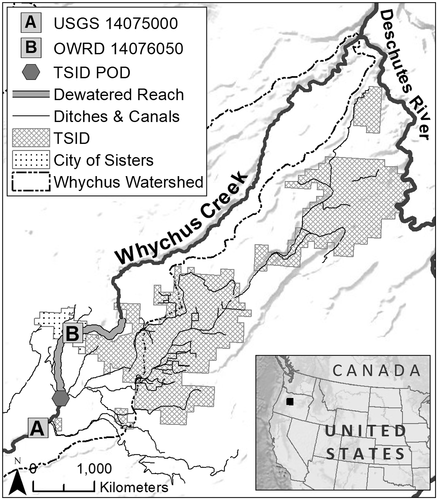

When demands exceed streamflow, diverters are curtailed in order of water rights priority. Because flows always exceed the combined diversion rates of senior (pre-1895) water rights, these rights have no risk of curtailment and are therefore the most reliable (Figure 2). Water rights with priority after 1895 are less reliable. In 1990, the Oregon Department of Fish and Wildlife established new instream water rights for Whychus Creek to support fish migration, spawning, egg incubation, fry emergence, and juvenile rearing. However, because of their junior priority, these rights are rarely fulfilled during the irrigation season.
In recent years, changing demographics of central Oregon have shifted the economic base, from logging and agricultural activities to tourism and recreation. Nearby Bend, Oregon, became a mecca for active outdoor enthusiasts. At $20 million, annual agricultural revenues now comprise just 0.3% of Deschutes County income (U.S. Department of Agriculture, 2014; U.S. Bureau of Economic Analysis, 2015).
The region's economic transformation spawned new organizations and partnerships to restore flows to the Deschutes River and its tributaries. In 1993, the nation's first water trust, the Oregon Water Trust, formed to secure instream water rights, with an early focus on Whychus Creek. In 1996, the U.S. Congress created the nonprofit DRC to restore streamflow and improve water quality in the Deschutes River watershed. Over time, environmental water transactions came to be the DRC's primary activity.
The DRC set a year-round environmental flow target of 20 cfs (0.57 m3/s), which it subsequently increased to 33 cfs (0.93 m3/s), to restore ecological functions to Whychus Creek. This target reflects the instream water rights established by the Oregon Department of Fish and Wildlife on Whychus Creek below Sisters (Certificate #73223 with a priority date of October 11, 1990).
The DRC, the Oregon Water Trust, and local partners engaged Whychus Creek water users in an EWTP to meet this target. As the largest water rights holder on the creek, TSID has been an active participant. This long-term EWTP represents a complex portfolio of water transactions focused on environmental objectives, which clearly affected other water-use sectors. Here, we summarize our analysis of transactions that the program carried out from 2000 through 2015.
By 2015, approximately 60 water transactions had shifted some 160 irrigation water rights of various priorities to instream flows in Whychus Creek, securing about 30 cfs (0.93 m3/s) of environmental flow at a cost of $17 million (Aylward and O'Connor, 2017). The bulk of this water was acquired through collaborations with TSID to eliminate water conveyance losses by installing pipes in place of ditches and canals and upgrading other irrigation infrastructure, and then transferring the saved water to instream flow rights. The purpose of these conveyance improvements was not to reduce crop water consumption, but rather to shift the location and timing of historical diversions in a way that would also shift the location and timing of streamflow to meet the flow target. (Some water savings were allocated to the irrigation district to increase the reliability of its water supply.) Before the transaction program, excess irrigation water returned to Whychus Creek downstream of the depleted reach or to locations outside the Whychus Creek watershed. By reducing the volume of irrigation diversions, the environmental water transactions reduced these return flows and substantially improved environmental flows in the depleted reach during the irrigation season.
Environmental Flows
Streamflow during the summer irrigation season has demonstrably increased due to the transaction program (Figure 3, left). Both the proportion of each year in which environmental flow targets are not met and the volumetric deviation from flow targets (shown in red in Figure 3, right) have decreased over the period of the program. The increase in frequency of environmental flow target attainment (Figure 4, left) shows a significant positive trend, although targets are still not met for much of the peak irrigation season (July–September; Figure 4, right). However, volumetric deficit from targets has decreased over time (Figure 5, left) and flows have been restored to more than 70% of target volumes for all months of the year (Figure 5, right).
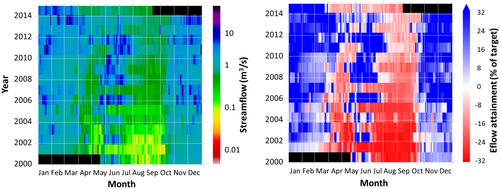


Reliability of instream flow rights is as critical to flow restoration in Whychus Creek as simply acquiring the rights. In the first five years of the program, instream flow rights totaled <10% of the target volume, but were secure because they had high seniority. Over time, the volume of instream flow rights has increased to exceed the environmental flow target. By 2015, more than 90% of environmental water was held as instream flow rights that were considered highly or moderately secure. However, even moderately secure water rights cannot meet the flow target in severe drought years like 2015 (Figure 6, left). The duration of environmental flow protections has also increased over time. Early in the program, temporary transactions made up half of the volume of instream rights. As time progressed, most rights held for environmental purposes have been permanently dedicated to instream flow (Figure 6, right).
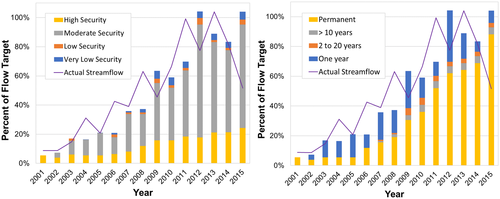
The cost-effectiveness of environmental flow transactions is measured as the financial cost of water ($/m3/yr) from the perspective of the party acquiring the water (Aylward et al., 2016a). The Whychus Creek EWTP pursued three strategies to secure environmental flows: instream transfers (permanent water rights purchases), instream leases (temporary agreements to forgo irrigation for specific periods of time), and conserved water (legal protection of water instream that was saved through infrastructure improvements). Overall, conserved water generated the most water per transaction compared to instream leases and transfers. However, cost-effectiveness was highly variable across the infrastructure projects (Figure 7, left). For a similar volume of water (e.g., 10 million m3), instream transfers were generally more cost-effective than conserved water transaction strategies. When the transactions are evaluated over time, trends in marginal cost (i.e., cost of each additional unit of water) can be evaluated. In Whychus Creek, the cost of each water acquisition increased through time, confirming that lower cost opportunities were exploited first (Figure 7, right).

Rural Economics
Despite concerns about rural economic impacts of reallocating water rights from irrigation to instream flow, the Whychus Creek transaction program had no detectable adverse effects. From 2000 to 2015, the economic productivity of irrigated water remained constant. Moreover, the irrigated area declined by only 5% (Figure 8). As most of the senior water rights that were purchased for transfer to instream flow came from within or adjacent to the City of Sisters, the net impact of these transfers on the local economy was likely positive. The irrigated farms in the Whychus system are resilient to reallocation of water because the bulk of instream water rights have been obtained from sources that had not previously been consumed by crops, but rather leaked from ditches and canals. Conserved water projects reduced transmission losses and increased reliability of water delivery, thus allowing farmers to maintain crop production while diverting less water. Changes in irrigated farm labor were not analyzed in the Whychus Creek system, but estimates suggest that no significant changes occurred, due to the stability and extent of irrigated area.
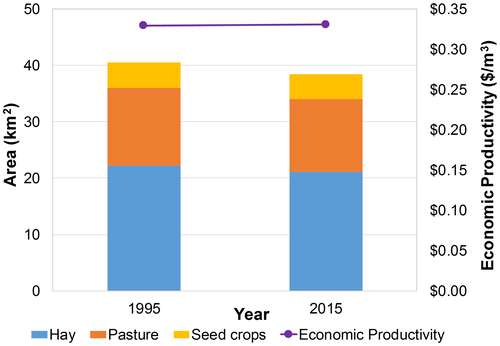
M&I Water Supplies
The City of Sisters (population 2,000) enjoys an abundance of reliable, high-quality groundwater, its primary source for domestic water use. In 2015, the driest year on record, there were no curtailments for Sisters’ customers, even as TSID water users endured drastically reduced summer allocations of surface water from Whychus Creek. The city began developing wells to supplement existing surface water supplies in the 1980s. By 2000, high surface water treatment costs led the city to move exclusively to groundwater (HGE, 2005). The city continues to develop groundwater wells and, to fulfill requirements of the Oregon Water Resources Departments’ Deschutes Groundwater Mitigation Program, leased and then transferred its surface water rights to instream use. Thus, Sisters has benefited from water transactions by switching to groundwater and using its surface water rights as mitigation to offset the impacts of its new groundwater pumping.
Multisector Water Use and Allocation
Annual water use estimates for Whychus Creek (Figure 9) confirm the increase in environmental flows over the transaction program period. While the proportion of water being used for irrigation has reduced as a result, the agricultural economy has experienced little to no adverse impact from these transactions. Municipal withdrawals remain a minimal fraction of total withdrawals.
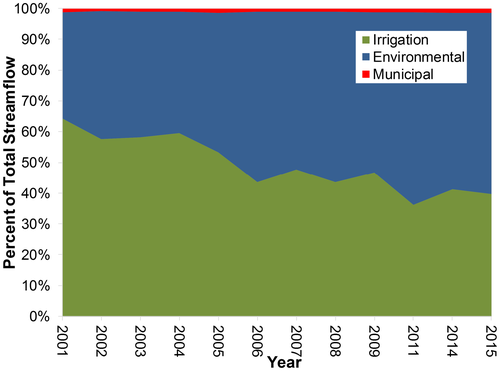
Changes in water allocations (Figure 10) reflect the shift in surface water rights ownership. In the mid-1990s, prior to the transaction program, irrigators held the vast majority of surface water rights from Whychus Creek, with the City of Sisters holding a small allocation of senior rights and some junior rights. By 2015, one-fifth of irrigation water rights and all of Sisters’ municipal water rights had been transferred or leased for environmental flow. As referenced earlier, the predominance of conserved water projects in the portfolio means that permanent and temporary reductions in irrigated area account for just one-third of the change (7% of irrigation rights); most of the new environmental flows came from irrigation water that was formerly lost during conveyance (14% of all irrigation rights). In addition, although not represented in the graphic, the irrigation district retained a portion of the water saved by efficiency projects, thus improving the overall reliability of its water rights portfolio.
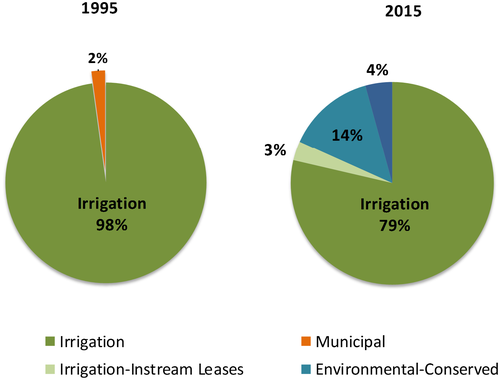
Maintaining Rural Economic Vitality in the Walker River Basin, Nevada
The Walker River flows from the Sierra Nevada Mountains in California into Nevada, eventually reaching its terminus in Walker Lake (Figure 11). Upstream flow depletions have deprived the lake of sufficient freshwater inflows, causing the lake's level to fall and salinity to increase, leading to extirpation of native aquatic species and reducing critical habitat for migratory birds that feed upon them. The Walker Basin Conservancy, a Nevada nonprofit organization established by the National Fish and Wildlife Foundation, is leading an ambitious suite of long-term efforts to restore water inflows and quality to Walker Lake for fish and wildlife, while protecting agricultural and watershed interests throughout the Walker River Basin (National Fish and Wildlife Foundation, 2016).
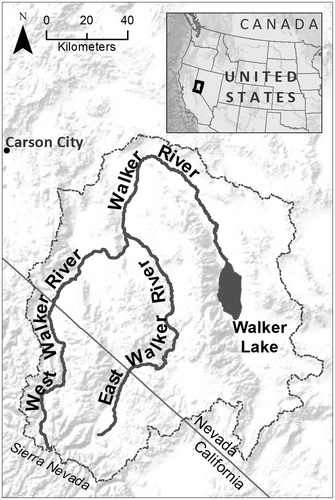
These efforts, organized collectively as the Walker Basin Restoration Program, focus on reducing consumptive use of water in agriculture, primarily by purchasing irrigation water rights from willing sellers and transferring them to Walker Lake. The program projects that the transfer of irrigation rights from 20% of the 526 km2of irrigated land in the basin to environmental flow will be necessary to restore lake salinity to a level that supports fish and wildlife (Borgen et al., 2014). However, removing one-fifth of the agricultural land from production could affect the rural economy. To mitigate potential economic impacts, the program is helping to transition a portion of agricultural lands from irrigated pasture and hay to vegetable crops that can generate much greater revenue per km2. In a pilot project, the program acquired more than 8 km2of irrigated pasture and hay fields with water rights, and then sold 1.5 km2to a local vegetable farmer. They revegetated the remaining area with native plants to convert it to upland wildlife habitat. Additionally, the program sold the grower groundwater rights from a separate transaction, providing a reliable source of irrigation water for vegetables and enabling eventual transfer of the full surface water rights associated with the 8 km2to instream flow (after the restored native vegetation establishes). Based on initial results, the program estimates that agricultural revenues could be held stable in the Walker Basin if 1 km2of irrigated vegetables were to replace every 12.5 km2of irrigated hay and pasture retired due to program acquisitions. Figure 12, based on the initial suite of program transactions (including the pilot project), shows that through 2015, gross agricultural revenue per unit of water consumed has increased, even though the irrigated area has decreased. At the same time, labor on irrigated farms decreased only slightly because vegetable production is much more labor-intensive than hay and pasture production (Figure 13).
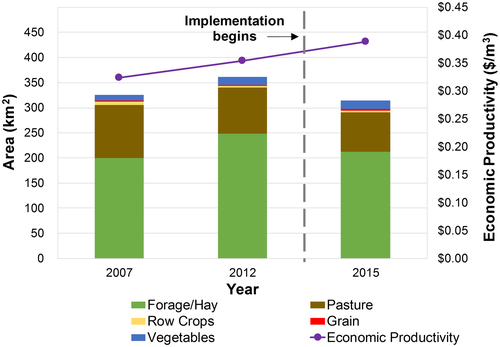
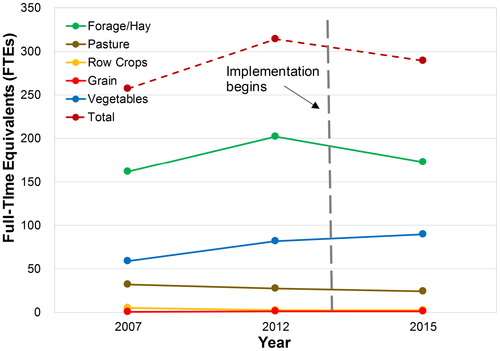
These preliminary results demonstrate that by switching to higher-value, lower-water-use vegetable crops, water transaction programs may reduce the total area of irrigated cropland while maintaining crop revenues and increasing the economic productivity of water. Supporting the local economy through this kind of crop and source-water transition is just one of multiple measures that such programs may take to mitigate the effects of reducing the irrigated area. The Walker Basin Conservancy is also implementing a large-scale land and water stewardship program to avoid dust and weed problems on lands from which water rights are transferred and a basin-wide water management modernization program (National Fish and Wildlife Foundation, 2016).
Discussion
Several insights emerge from the development and application of our evaluation framework for EWTPs. These insights reflect the challenging nature of managing competition for scarce water supplies in the American West.
Transactions Designed to Increase Streamflow Can Benefit Multiple Sectors
For each of our case studies, environmental water transactions had positive effects on other water users, due to the underlying strategies employed. In the Whychus Creek basin, for example, TSID now enjoys more reliable water delivery because of irrigation infrastructure improvements. By switching entirely to groundwater and transferring its surface water rights to instream flows, the City of Sisters reduced future impacts of drought on its water supply and bolstered Whychus Creek's flows. Through this series of innovative transactions, environmental flow augmentation has improved aquatic health in Whychus Creek (Mazzacano, 2015), while also benefiting agricultural and municipal sectors.
Indicators Illuminate Tradeoffs
When used for planning purposes, the indicators illuminate tradeoffs between alternative transaction scenarios. When used retrospectively, they quantify the impacts of the alternatives chosen.
As we developed our framework, we tested provisional indicators with several incipient EWTPs in their strategic planning phases. The process of compiling and inputting data for the indicators revealed options as well as omissions that previously had not been considered. Importantly, the indicators quantified tradeoffs between different possible program designs, with some clearly generating more diverse benefits than others. For example, in one case, dry-year contracts were shown to be the most cost-effective way for a municipal water utility to meet demands during drought years (Scenario 3, Figure 14; in Scenario 1, the utility would purchase water rights directly from farmers; in Scenario 2, the utility would purchase water rights from a local water exchange). By precluding the permanent retirement of irrigated land, dry-year contracts will also help sustain the local rural economy.
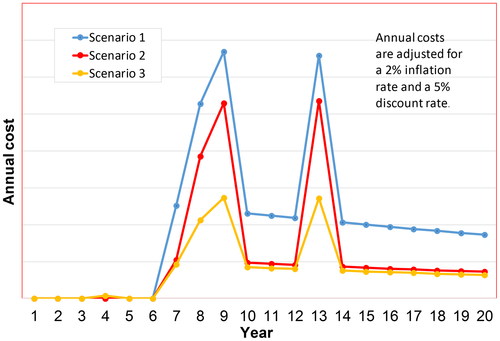
Retrospective analyses highlight consequences of tradeoffs accepted during program development. During its early years, for example, the Whychus Creek EWTP leased instead of purchasing instream flow rights in exchange for gaining the trust of the farming community. Although these initial transactions were temporary, the tradeoff proved valuable in the long run, when collaboration with the irrigation district led to a large portfolio of permanent instream flow rights (Figure 6).
When used to track program success, the evaluation framework helps guide programs to manage tradeoffs efficiently. The Walker River EWTP anticipated that retiring irrigation would significantly reduce agricultural revenues. By design, the program mitigates the impacts of that tradeoff by replacing every 12.5 km2of retired hay and pasture with 1 km2of high-value vegetables. The rural economic indicators confirm that the mitigation is successful. As the program matures, it will continue to track these indicators and adjust its mitigation strategy as warranted.
Hydrology Matters
Successful environmental water transactions require a solid understanding of the entire water budget — where, when, and how much water is diverted, consumed, and returned, both before and after transactions. In most cases, increasing environmental flows require a commensurate reduction in water consumption (evaporation, transpiration, and/or transbasin diversion). For example, restoring lake levels in Walker Lake could only be achieved by reducing consumptive water use in the Walker River Basin — that is, by reducing the irrigated area and/or the irrigation season. Thus, the Walker Basin Restoration Program retires irrigated land, purchases the water rights, and transfers them to instream flow.
On the other hand, if flow restoration is targeted to a specific river reach or time of year, then more transaction strategies may be available. To restore flows to the 8-km dewatered reach of Whychus Creek, the water transaction program increased the efficiency of irrigation conveyance. Generally, reducing water conveyance losses or improving on-farm water-use efficiency reduces the volume of water withdrawals, but does not reduce water consumption, if crop production remains stable or increases (Ward and Pulido-Velazquez, 2008; Perry, 2011; Molle, 2017; Richter et al., 2017). But reducing withdrawals from Whychus Creek left more water in the dewatered reach when it was most needed, without reducing crop production.
Irrigation efficiency improvements can also, however, reduce return flows upon which downstream ecosystems and water users may depend. Reducing withdrawals from the dewatered reach of Whychus Creek reduced late-season return flows to the lower reach as well as to the adjacent watershed. In doing so, the transactions restored a more natural flow regime to all three reaches. An understanding of the local hydrologic system allowed the Whychus Creek transaction program to foresee how piping ditches and canals would achieve flow objectives while avoiding unintended consequences of altering the return flow regime.
Legal Framework Matters
Not all states allow the types of transactions that restored flows to Whychus Creek. Therefore, understanding how the prevailing law supports transaction strategies is as critical as understanding the hydrology. Reducing return flows is allowed under Oregon law, where downstream users relying on lagged return flows are subject to the will of the diverter. Oregon also has clear rules about allocating water saved through irrigation efficiency improvements: some of the water must go to the environment, some must be available to other water users, and some the irrigator may keep. Moreover, Oregon law allows rights to the saved water to be formally transferred to senior instream flow rights, thereby preventing other users from diverting it for their own use. Therefore, reducing leakage from canals was an appropriate strategy for restoring flows to Whychus Creek.
Multisector Water Transactions Can Improve Cost-Effectiveness
At first glance, the $17 million price tag to restore 0.85 m3/s to Whychus Creek seems rather high. The reality is that low-cost water for environmental flows no longer exists in most areas of the West. This case study demonstrates that by working together, the water transaction program and TSID achieved both of their objectives — environmental flow restoration for the environment, and irrigation-supply reliability and economic sustainability for farmers. Water savings from conveyance improvements were shared between district irrigation users and instream flows. The increased water reliability for irrigation explains the high cost per volume of environmental water, compared to purchasing environmental water directly. Although neither entity alone could afford to pay $17 million, the multisector, multiobjective nature of the transactions attracted funding from both private and government sources, which otherwise would not have supported either entity alone.
Conclusions
The evaluation framework described in this paper reveals numerous ways in which EWTPs can improve outcomes not just for environmental flows, but also for other water users. Our suite of evaluation indicators has enabled us to document the following:
- EWTPs are succeeding in their mission; there is evidence to show that they are moving water back to the environment;
- When executed carefully with attention to avoiding unintended consequences, multiobjective transactions can generate mutually beneficial outcomes among environmental, agricultural, and municipal interests;
- Water can be reallocated to the environment without harming agricultural economies, especially if coordinated with appropriate investments in infrastructure and/or cropping changes;
- The ease and cost of water transactions can be expected to change over time, as disparities in the marginal value of water between economic sectors converge. Environmental flow programs should plan and budget accordingly. Transactions that are designed to benefit multiple water-using sectors may reduce each participant's transaction costs.
These indicators are replicable and applicable in diverse settings. They can be calculated using information that is publicly available, or that can be provided by transaction participants. They can be used to track and retrospectively evaluate prior transactions, or to plan, evaluate, and prioritize among potential future transaction strategies. Importantly, our indicators are transparent and straightforward to generate.
An important benefit of developing a standardized set of indicators is to encourage the collection and consistent use of data to facilitate comparisons across transaction programs. We recommend that data sources, collection methods, and analyses be incorporated early in transaction program design. Our framework is sufficiently flexible to be adapted to other transaction contexts, such as water quality markets, wetland mitigation programs, or habitat conservation programs for species of concern. Finally, the indicators can be used by agriculture and M&I sectors seeking to improve access to, or reliability of, water supplies, while considering potential impacts to other water-using sectors and environmental flows.
In general, multisector analysis holds promise for creating novel partnerships and mobilizing new funding streams. The standardized and broadly applicable evaluation framework described in this paper can accelerate the growth of existing water transaction programs and catalyze new multisector approaches for improving environmental flows while generating system-wide benefits.
Acknowledgments
We gratefully acknowledge the following water transaction practitioners for their participation in developing and applying the evaluation framework, although we could not summarize all of their case studies here: Tim Davis, Lain Leoniak, and Deborah Stephenson (Gallatin River, Montana); Nancy Smith, Bryan McFadin, and Jennifer Carah (Navarro River, California); Mark Davidson and Dayna Gross (Wood River, Idaho); David Yardas (Walker River, Nevada); as well as Andrew Purkey, Ron Nelson, and Clay Landry. We also thank Julien Brun for helping with data management, Catherine Petersen for formatting figures, and Rachel O'Connor for drafting maps. Finally, we extend gratitude to three anonymous peers, whose reviews greatly improved this paper. This research was conducted by the Water Sharing expert working group supported by Science for Nature and People Partnership (SNAPP), a partnership of The Nature Conservancy, the Wildlife Conservation Society, and the National Center for Ecological Analysis and Synthesis (NCEAS) at the University of California, Santa Barbara.



